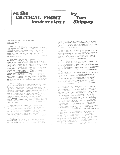 on the
on the
CRITICAL FRONT
book reviews
bY TOM
Shippey
THE LIGHT OF OTHER DAYS by Bob Shaw. Collancez, [British pound sigh]1.80
This is Bob Shaw's 'slow glass' novel. Its basic concept - glass which, instead of allowing light to pass through directly, somehow absorbs it to be released later -must be familiar to most people, ever since the success of the short story 'Light of Other Days'.
The question which naturally arises, however, is whether Shaw has been able to make a successful transition from a series of short stories to a connected novel : and it's fair to say at the start that there must be at least some doubt over this. What Shaw has donet essentially, is to cast the hovel in a form similar, sayt to Damon Knight's A FOB ANYTHING, that is, as a novel which follows an invention through from its first conception (at which stage its possibilities seem enormous and on the whole beneficial) to a point where its true impact on the world becomes destructively obvious.
These developments are seen for the most part through the eyes of Al Garrod, the inventor and developer of 'slow glasst, but particular stages are caught in 'sidelights', vignettes involving people outside his area of knowledge, and assumed to be representative. These are in fact the previously published stories 'Light of Other Days' from Analog August '66, and 'Burden of Proof' from Analog May '67. I don't know where the thirdt f The Planner and the Private' appeared firsty but it too has the look of separate publication.
Some people may feel that these pieces are Shaw's basic conception, and that the rest of the story has just been written round them, losing impetus as a result. And while I don't think this is exactly true, there is nevertheless a distinctly 'episodic' quality even about the main plot-line itself.
We skip, for instance, over nine years between chs. 2 and 3 (with 'Sidelight One' in between)I and though this may be inevitable
in a story of technological development, interest is split further by having Garrod act later on as a kind of 'slow glass detective in two separate murder enquiries, in chs. 5-7 and 9-14.
It is meanwhile most surprising that in spite of the continuing thread of Garrod's failing marriage, we lose all sight of Jane Wason, his wife's rival, for some 80 pages in the middle (pp. 46-126); and the ending is extremely curtailed.
What seems to have happenedT thought is not that Shaw has 'filled in' around previous successes, but that in writing the novel his attention has been divided between the technological theme and the personal one, with each getting on top at different times.
Viewed from a personable angler the book is about dominance. A1 Garrod begins as a relatively unimportant research scientist with a rich and imperious wife to whose father he is heavily indebted. But his realisation of what 'slow glass' is and does puts him instantly into a much more powerful position.
Shaw does this very well in the first two chapters, making first the point about serendipity - for to everybody else 'slow glass' is just a dangerous flaw - and then the one about creative imagination. As Esther, his wife, is berating him first for thinking 'slow glass' important and then (a fine tactical switch) for keeping it to himself, Garrod holds a disc up to the sun, walks into the darkest corner of the room, and then allows the delayed and imprisoned rays to flash out : 'Esther took a step backwards and shielded her eyes. In his hands, blinding in its red-gold magnificence, Garrold held the setting sun.'
The silent demonstration of potential of course wins him the argument. But the 'setting sun' also perhaps suggests the dc!3tructive nature, to the world as a whole, of Garrod's moment of imagination; it certainly prefigures the effect 'slow glass'
will have on Esther. The single scene concisely indicates Garrod's new strengthI
as also the danger of using it.
Document scaning and conversion provided by Peter Barker
Updated May 12, 2015. If you have a comment about these web pages please send a note to the Fanac Webmaster. Thank you.